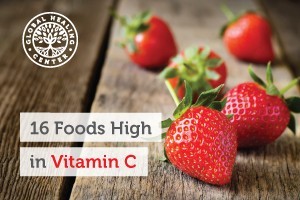
Vitamin C is an important, naturally-occurring nutrient. From deterring cold and flu,[1] to rebuilding tissue, bones and blood vessels,[2] and boosting the body's ability to synthesize calcium,[3] vitamin C is something we all require on a daily basis.
Studies have confirmed that vitamin C not only supports brain function,[4] but also helps you heal from injuries[5] and recover from illness.[6] A potent antioxidant for neutralizing free radicals, a diet lacking vitamin C may lead to health issues over time.[7] According to the Food and Nutrition Board at the Institute of Medicine, we should all eat vitamin C foods on a daily basis; men require about 90 mg and women require 75 mg every day.[8]
The following foods are high in vitamin C and will super-charge your diet with a major serving of this essential nutrient.[9]

Foods High in Vitamin C
Length: 3 minutes
16 Foods High in Vitamin C
1. Strawberries
One of the tastiest and healthiest berries on the planet, strawberries are extremely high in vitamin C. They're also high in fiber and antioxidants, which are responsible for reducing oxidative stress and protecting the heart from bad cholesterol.[10, 11] Just one serving provides about half of your daily vitamin C requirements.
2. Acerola Cherry
The acerola cherry (Malpighia punicifolia) — also called Barbados cherry — is a small, red fruit but it's packed with vitamin C! It contains about 65 times more vitamin C than an orange. Fresh, raw acerola cherries are available, but if they're not in season, you can also buy them in supplement form.
3. Citrus Fruits
Oranges, grapefruits, lemon and limes! Citrus fruits pack a powerful vitamin C punch. Enjoy one medium orange for a whopping 70 mg. A small glass of orange juice has up to 93 mg of vitamin C, and a small glass of grapefruit juice has up to 70 mg of vitamin C. Even though oranges are probably the most popular vitamin C food, they don’t have the highest amount.
4. Kakadu Plums
Kakadu plums, native to Australia, are an incredible superfood, with some of the highest vitamin C content in any fruit on earth.[12] They also contain the antioxidant ellagic acid, which has excellent health benefits.
5. Black Currant
With its dark purple hue, it's easy to imagine that this fruit would be high in vitamin C. Black currants hold around 180 mg per serving, as well as plenty of potassium, iron, vitamin B5, and phytochemicals.[13]
6. Kiwi
It may surprise you to learn that this small bright green fruit from New Zealand has more vitamin C than an orange! They are also high in flavonoids and have as much potassium as a banana.[14] Studies have shown that children who eat these vitamin C-rich fruits experience stronger respiratory tract health than children who do not.[15]
7. Bell Peppers
Bell peppers are another food high in vitamin C, as well as beta-carotene. These colorful veggies have been studied for cardioprotective benefits, and have also been shown to prevent cataracts, blood clots, and may even reduce the risk of heart attack or stroke.[16] One-half cup of raw red pepper holds over 140 mg of vitamin C. All bell peppers are high in vitamin C, but yellow has the most and red peppers come in second.[17]
8. Guava
This exotic fruit is another great vitamin C food, with one guava containing over 250 mg. That's over twice your daily requirement! They are also rich in dietary fiber, folic acid, potassium, and manganese, making guavas one of the best superfoods to add to your diet.[18] Many supermarkets are now importing these fruits from the tropics, so they are easy to find.
9. Brussels Sprouts
While not everyone's favorite food, Brussels sprouts have an excellent reputation as a source of vitamin C. One serving of cooked Brussels sprouts has almost 50 mg of vitamin C. Brussels sprouts are also high in vitamin K, folate, vitamin A, manganese, potassium, and dietary fiber.[19]
10. Melons
Many melons contain vitamin C. Just one cup of cantaloupe will provide you with approximately 67 mg of vitamin C, plus plenty of vitamin A and potassium. Additionally, watermelon is another great source of vitamin C, as one serving will give you 112 percent of your daily requirement.[20]
11. Dark Leafy Greens
Kale, mustard greens, turnip greens, watercress, chard, and spinach (as well as most other leafy greens) are all great vitamin C foods to add to your diet. While they all provide different amounts of this essential nutrient, they are all very healthy for you. Kale is the best choice, as it may have up to 130 mg of vitamin C in one serving — that’s one full day’s requirement of vitamin C!
12. Camu Camu Fruit
An exotic berry from the Amazon rainforest, this nutrient-dense superfood is high in C as well as flavonoids and anthocyanins.[21] Because of its tart flavor, it's generally used in powder or supplement form for its immune-boosting properties.
13. Broccoli
Whether you eat it raw or cooked, you can never go wrong with broccoli. One serving of this little green tree has over 90 mg of vitamin C. As a bonus, broccoli is also one of the best detox foods to add to your diet.
14. Amla (Indian Gooseberry)
The amla fruit, also known as Indian gooseberry (Emblica officinalis), is incredibly high in vitamin C. One berry has 600 to 700 mg of vitamin C — second only to Acerola cherry![22] They also contain tannins, which have additional antioxidative properties, as well as the potent polyphenol gallic acid, which promotes immunity.[22]
15. Tomatoes
Bright, red tomatoes are another common vitamin C food. Try using sun-dried tomatoes; they are particularly concentrated with this essential nutrient. Just one, 100-gram serving holds over 100 mg of vitamin C. This equals 170 percent of your daily requirement.[23]
16. Select Herbs
Many fresh herbs such as cilantro, chives, thyme, basil, and parsley are high in vitamin C. Buy some fresh herbs and sprinkle on every meal. In fact, just one cup of fresh parsley has over 130 mg of vitamin C. Thyme comes in first, with 160 mg in one cup.[24]
There you have it, 16 delicious foods that are great sources of vitamin C. If you don't get enough of these fruits and vegetables, consider Global Healing's Organic Plant-Based Vitamin C.
References (24)
- Gorton HC, Jarvis K. The effectiveness of vitamin C in preventing and relieving the symptoms of virus-induced respiratory infections. J Manipulative Physiol Ther. (1999): 530-533.
- Wei F, et al. Vitamin C treatment promotes mesenchymal stem cell sheet formation and tissue regeneration by elevating telomerase activity. J Cell Physiol. 2012:3216-3224.
- Morton, DJ, et al. Vitamin C Supplement Use and Bone Mineral Density in Postmenopausal Women. J Bone Miner Res. 2001:135–140.
- Masaki KH, et al. Association of vitamin E and C supplement use with cognitive function and dementia in elderly men. Neurology. 2000:1265-1272.
- Mohammed BM, et al. Vitamin C promotes wound healing through novel pleiotropic mechanisms. Int Wound J. 2016:572-584.
- Lee JY, et al. Fluoxetine and vitamin C synergistically inhibits blood-spinal cord barrier disruption and improves functional recovery after spinal cord injury. Neuropharmacology. 2016:78-87.
- Carr AC, Frei B. Toward a new recommended dietary allowance for vitamin C based on antioxidant and health effects in humans. Am J Clin Nutr. 1999:1086-1107.
- David Zieve, David R. Eltz. Vitamin C. National Library of Medicine. 2011 August 30.
- United States Department of Agriculture. National Nutrient Database for Standard Reference Release.
- Ajibade TO, et al. Modulatory effects of melatonin and vitamin C on oxidative stress-mediated haemolytic anaemia and associated cardiovascular dysfunctions in rats. J Complement Integr Med. 2017 Mar 1;14(1).pii: /j/jcim.2017.
- Alvarez-Suarez JM, et al. One-month strawberry-rich anthocyanin supplementation ameliorates cardiovascular risk, oxidative stress markers and platelet activation in humans. J Nutr Biochem. 2014:289-294.
- Williams DJ, et al. Organic acids in Kakadu plum (Terminalia ferdinandiana): the good (ellagic), the bad (oxalic) and the uncertain (ascorbic). Food Res Int. 2016 Nov;89(Pt 1):237-244.
- United States Department of Agriculture. National Nutrient Database for Standard Reference Release.
- United States Department of Agriculture. National Nutrient Database for Standard Reference Release.
- Ferrara P, et al. Beneficial therapeutic effects of vitamin C on recurrent respiratory tract infections in children: preliminary data. Minerva Pediatr. 2016.
- Sharma R, et al. Effect of pre-treatments and drying methods on quality attributes of sweet bell-pepper (Capsicum annum) powder. J Food Sci Tech. 2015 Jun;52(6):3433-3439.
- United States Department of Agriculture. National Nutrient Database for Standard Reference Release.
- United States Department of Agriculture. National Nutrient Database for Standard Reference Release.
- United States Department of Agriculture. National Nutrient Database for Standard Reference Release.
- United States Department of Agriculture. National Nutrient Database for Standard Reference Release.
- Langley PC, et al. Antioxidant and associated capacities of Camu Camu (Myrciaria dubia): a systematic review. J Altern Complement Med. 2015 Jan 1; 21(1): 8-14.
- Goraya RK, Bajwa U. Enhancing the functional properties and nutritional quality of ice cream with processed amla (Indian gooseberry) J Food Sci Technol. 2015 Dec;52(12):7861–7871.
- United States Department of Agriculture. National Nutrient Database for Standard Reference Release.
- United States Department of Agriculture. National Nutrient Database for Standard Reference Release.
†Results may vary. Information and statements made are for education purposes and are not intended to replace the advice of your doctor. If you have a severe medical condition or health concern, see your physician.




